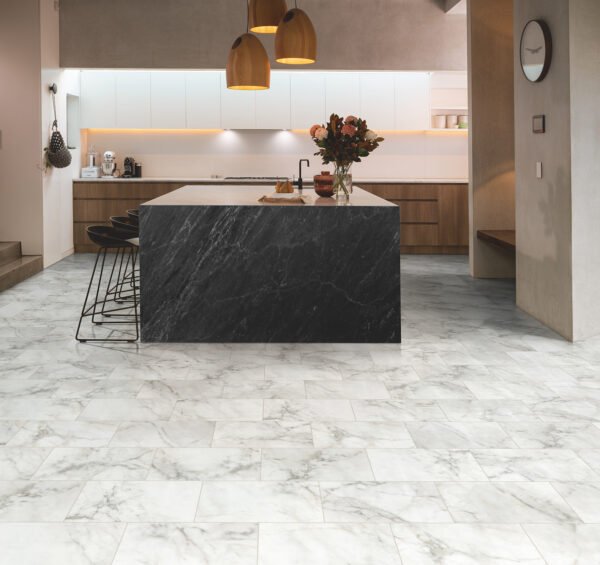
Picking the Best Kitchen Tiles
Choosing new kitchen tiles should be simple (and fun!), but with hundreds of options for materials, sizes, and colours, it’s easy to feel overwhelmed. We have talked to Natural Stone & Timber and they gladly agreed to help us with preparing a quick guide to some of the most popular kitchen flooring options. So, in this article we are going to briefly explain what they are, talk about any considerations to think about, give some pros and cons for each and a score between 1 to 5 for a cost guideline.
Natural stone tiles for kitchen flooring
Natural stone tiles are a timeless and durable option for kitchen flooring. Each piece is unique with variations in colour, pattern and texture. They’re cut to various sizes and finishes ranging from polished to honed or brushed, large format slabs or smaller and mixed size tiles, giving you a wide range of options to choose from. You’ve got different types of natural stone tiles to choose from:
- Marble
- Limestone
- Slate
- Travertine
- Sandstone.
What you need to consider with all these options is sealing. Most natural stone is porous and requires sealing to help prevent stains and moisture absorption. Another important thing is – professional installation. We are not saying you can’t DIY this, but typically they’re a bit more complicated to work with. So if you don’t have any experience with installing natural stone tiles, then it’s better to find a specialist who can help you with this.
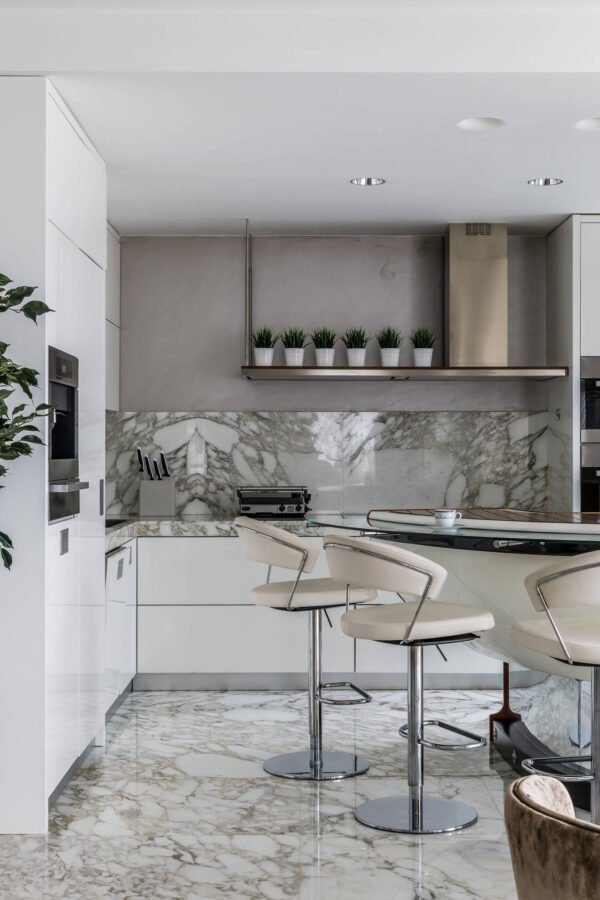
You should also know that natural stone tiles are compatible with underfloor heating. In fact, stone tiles are well suited for use with underfloor heating systems. Their thermal conductivity allows the heat to be evenly distributed and retained.
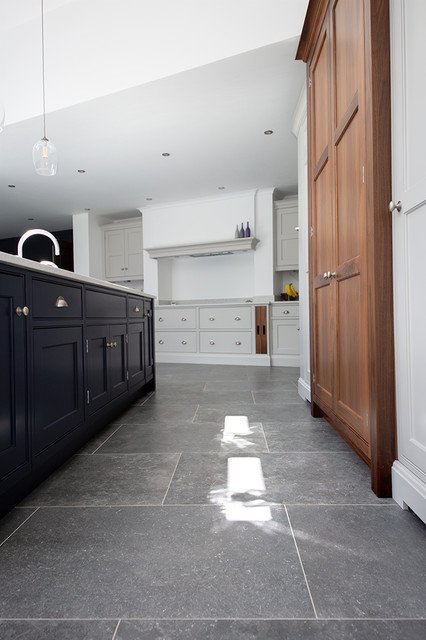
Now, let’s go to the pros of stone tiles for kitchen flooring:
- Durability. Natural stone is very durable and can withstand the demands of a busy kitchen.
- Aesthetic appeal. Each tile is unique, offering that natural beauty that can enhance the look of your kitchen.
- It can add value to your home. High quality stone flooring can increase the resale value of your home, if that’s something that you’re considering and thinking about.
- Good thermal conductivity. Ideal in warmer climates as it remains cool. It can help to regulate the room temperature, although that could also be a con if you live somewhere cold and don’t install underfloor heating. But also, as we said, they do work particularly well with underfloor heating to help distribute the heat.
Now, let’s go the cons:
- Price. One of the more expensive flooring options due to the cost of the material and potentially the installation. In terms of price, we’ve given them a 4 to 5 out of 5
- Maintenance. Requires sealing to protect against stains and moisture. And some stones may require more regular resealing as well.
- Comfort. It can be a little bit hard and cold underfoot, if you haven’t got underfloor heating, which may be uncomfortable during prolonged standing.
- Susceptible to damage. Although they are very durable, some softer stones like marble and sandstone can scratch or etch quite easily, especially if they’ve not been sealed and maintained properly.
But in general, this is a really great option if these cons aren’t a problem to you.
Porcelain and ceramic tiles are a very popular, versatile flooring option for kitchens. They are known for amazing durability and a wide range of designs. Both types of tiles are made from clay that is fired in a kiln, but porcelain tiles are made from a more refined clay and fired at higher temperatures. This process makes porcelain tiles denser and less porous than ceramic tiles, giving them slightly better durability and water resistance. Ceramic tiles, on the other hand, while still very durable and water resistant, are typically slightly more cost effective.
In terms of types, there are several variations:
- Glazed porcelain and ceramic tiles
- Unglazed, matte finishes or full body porcelain tiles.
Now, let’s talk about some considerations:
- Cutting the tiles. Porcelain tiles are often harder than ceramic, often requiring a diamond blade for cutting, whereas ceramic tiles can be cut with simpler tools.
- The adhesive and grout. You should use high quality adhesive or mortar suitable for this specific type of tile and consider using a complementary grout and one that resists moisture and stains
- Compatibility with underfloor heating. Porcelain and ceramic tiles are excellent conductors of heat, making them a good choice for underfloor heating systems, so there’s no problem there.
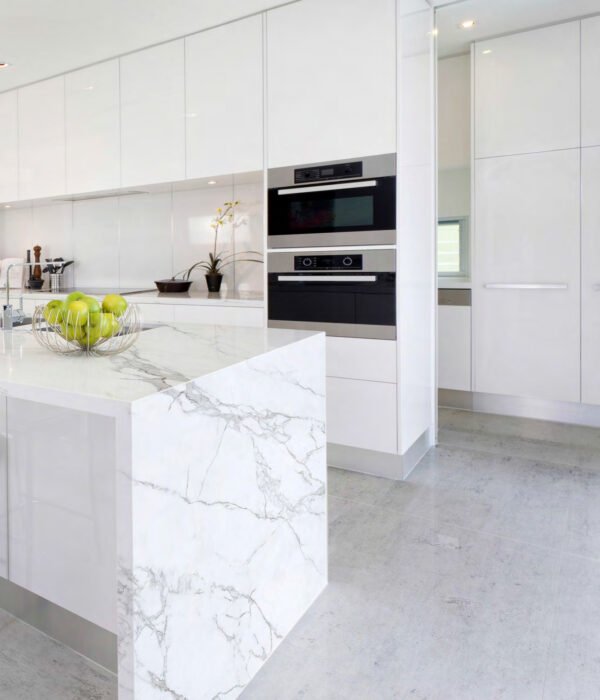
Some quick pros of ceramic and porcelain tiles for kitchen flooring:
- Durability. Both types are hard and durable, with porcelain tiles being especially resistant to wear and tear.
- Water resistance. Porcelain tiles are highly water resistant, making them ideal for kitchens. Ceramic tiles, when glazed especially, also offer good water resistance, but both are pretty good here.
- Maintenance. They’re easy to clean and maintain, requiring just regular sweeping and mopping. For the most part, they don’t need to be sealed, although we know some fitters do like to seal the grout.
- Design variety. They’re available in a huge range of colours, patterns and sizes. You’re bound to find something that fits your particular kitchen style.
And the cons:
- Price. Porcelain tiles tend to be more expensive than ceramic tiles due to their enhanced properties, but both can be expensive depending on what you pick.
- Cold and hard underfoot. Similar to natural stone tiles, without underfloor heating, ceramic and porcelain tiles can be cold and hard, which may be uncomfortable if you’re working in the kitchen and standing a lot.
- Installation. The installation process can be challenging, especially for porcelain tiles, so you’re likely going to need professional installation for the best results.
So depending on your particular circumstances, that’s definitely something to keep in mind. Cost-wise, we’ve given them a 3 to 4 out of 5. There’s such a vast selection of tiles available, from basic ceramic tiles to high-end porcelain tiles, that the cost really can vary.
Engineered wood flooring
Engineered wood flooring combines the beauty of natural wood with the enhanced stability and resistance to moisture, making it my preferred choice if you do want a wooden flooring option. This flooring type is constructed from multiple layers of plywood or high-density fiberboard, usually cross-bonded together, topped with a veneer of real solid hardwood.
This layered structure minimizes the wood’s natural tendency to expand and contract and warp with changes in temperature and humidity.
Some considerations to keep in mind when you want to install engineered wood flooring:
- The installation methods. It can be installed using floating, glued or nailed down methods, offering flexibility, based on the specific product and subfloor type that you have. So depending on your particular situation and circumstances of the room, this could be a little bit more DIY-friendly, or it might not be.
- Acclimation. Although engineered wood is less susceptible to environmental changes than solid hardwood, it still benefits from acclimatising to the room’s humidity and temperature before installation.
- Underfloor heating compatibility. Engineered wood is well-suited to use with underfloor heating systems due to its improved stability. The construction allows for efficient heat transfer and reduces the risk of warping and cracking.
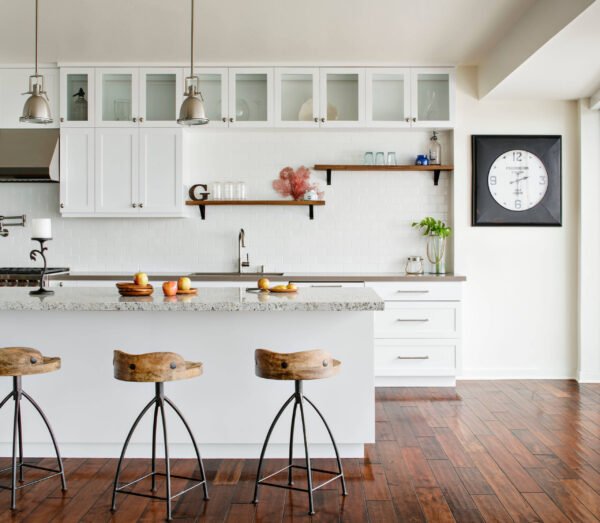
Let’s go briefly about the pros:
- Aesthetic appeal. Offers the look and feel of solid hardwood with more versatility.
- Moisture resistance. The layered construction provides better resistance to moisture and humidity changes, making it more suitable for kitchens.
- Durability. It’s pretty durable and stands up well in a busy kitchen.
- Ease of installation. It can be easier to install than solid hardwood, with some options that are a little bit more DIY-friendly.
And the cons:
- Cost. While generally less expensive than solid hardwood, high-quality engineered wood can be quite pricey.
- Refinishing limitations. The top veneer layer can be refinished, but it will likely only be able to be sanded and refinished a limited number of times depending on its thickness.
- Variability in quality. Quality of engineered wood can vary greatly depending on the thickness of the top layer and the core materials used, affecting its durability and refinishing potential. Usually the thicker the top layer, the more expensive they are.
- Sensitivity to extreme temperature changes. While much more stable than solid wood, engineered wood can still be affected by extreme humidity and temperature changes. So if you do live in a particularly bad area for this, it’s something to keep in mind.
Cost-wise, we’ve given it a 3 to 4 out of 5. Its price can vary widely based on the wood veneer’s thickness and quality. And although engineered wood is typically less expensive than solid hardwood, it’s still more costly than some of the other flooring options.














































